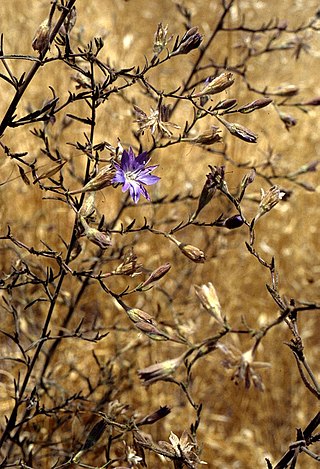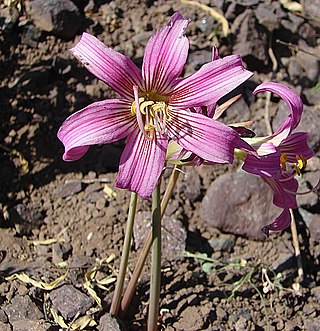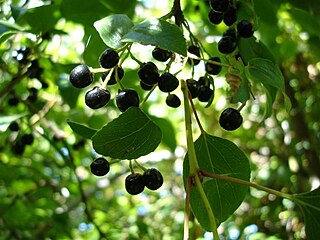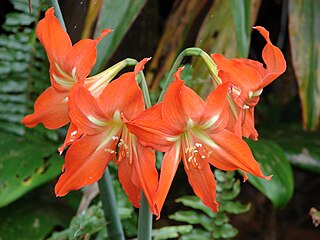Cypress is a common name for various coniferous trees or shrubs of northern temperate regions that belong to the family Cupressaceae. The word cypress is derived from Old French cipres, which was imported from Latin cypressus, the latinisation of the Greek κυπάρισσος (kyparissos). Cypress trees are a large classification of conifers, encompassing the trees and shrubs from the cypress family (Cupressaceae) and many others with the word cypress in their common name. Many cypress trees have needle-like, evergreen foliage and acorn-like seed cones.

Puya is a genus of the botanical family Bromeliaceae. It is the sole genus of the subfamily Puyoideae, and is composed of 226 species. These terrestrial plants are native to the Andes Mountains of South America and southern Central America. Many of the species are monocarpic, with the parent plant dying after one flower and seed production event.
Weberbauerella is a South American genus of flowering plants in the legume family, Fabaceae. It includes three species of perennial herbs or subshrubs native to coastal Peru and northern Chile. They grow in seasonally-dry tropical coastal forest, on sand or sandy hills. It was recently assigned to the informal monophyletic Dalbergia clade of the Dalbergieae.

Malesherbia is a genus of flowering plants consisting of 25 species in the Passifloraceae. This is a xerophytic group endemic to the Peruvian and Chilean deserts and adjacent Argentina. The genus is currently recognized by the APG III system of classification in the family Passifloraceae, and is the sole member of the subfamily Malesherbioideae.

Jubaea is a genus of palms with one species, Jubaea chilensis, commonly known in English as the Chilean wine palm or Chile cocopalm, and palma chilena in Spanish. It is native to southwestern South America and is endemic to a small area of central Chile between 32°S and 35°S in southern Coquimbo, Valparaíso, Santiago, O'Higgins, and northern Maule regions.

Hipólito Ruiz López, or Hipólito Ruiz, was a Spanish botanist known for researching the floras of Peru and Chile during an expedition under Carlos III from 1777 to 1788. During the reign of Carlos III, three major botanical expeditions were sent to the New World; Ruiz and José Antonio Pavón Jiménez were the botanists for the first of these expeditions, to Peru and Chile.

José Antonio Pavón Jiménez or José Antonio Pavón was a Spanish botanist known for researching the flora of Peru and Chile.
Clinopodium chilense, synonyms including Satureja gilliesii, is a plant in the family Lamiaceae. C. chilense is endemic to central Chile. It is found in the La Campana National Park area, in association with the endangered Chilean wine palm, Jubaea chilensis.

Rhodophiala was a genus of herbaceous, perennial and bulbous plants in the Amaryllis family. It consisted of about 30 South American species distributed in southern Brazil, Argentina, and, specially, in Chile. Most of the species are known colloquially as añañuca. It has now been submerged in Zephyranthes.

Rhodolirium is a small South American genus in the tribe Hippeastreae of the family Amaryllidaceae. Although originally described by Philippi in 1858 it has long remained buried in other taxa, principally Hippeastrum and more recently Rhodophiala. Only in recent years has it been rehabilitated.

Aristotelia chilensis, known as maqui or Chilean wineberry, is a tree species in the Elaeocarpaceae family native to South America in the Valdivian temperate forests of Chile and adjacent regions of southern Argentina. Limited numbers of these trees are cultivated in gardens for their small fruits. Wild-harvested fruits are commercially marketed.

Hippeastreae is a tribe of plants belonging to the subfamily Amaryllidoideae of the Amaryllis family (Amaryllidaceae). Species in this tribe are distributed in South America. Flowers are large and showy, zygomorphic, with the stamens in varying lengths, inflorescence bracts are often fused basally. The seeds are flattened, winged or D-shaped. Reported basic chromosome numbers are x= 8-13, 17, and higher. All the species in this tribe present a remarkable aesthetic interest and horticultural value.

Phycella is a genus of herbaceous, perennial bulbous flowering plants belonging to the family Amaryllidaceae, subfamily Amaryllidoideae. The genus consists of five species distributed from central Chile to northwestern Argentina.

Eustephia is a genus of South American plants in the Amaryllis family. All 6 known species are native to Peru, with the range of one species extending also into Bolivia.

Salix humboldtiana, called Humboldt's willow, is a tree species of willow native to North and South America, growing along watercourses. Some authorities consider it a synonym of Salix chilensis, which Molina described in 1782. Willdenow described Salix humboldtiana in 1805.

Eriosyce chilensis or "Chilenito" is a critically endangered species of cactus from Chile. Found on the coast between Coquimbo and Valparaiso, the plant is one of the world's 100 most threatened species according to the IUCN. Its rarity is primarily due to its small native habitat range and illegal overcollection for the ornamental cactus trade. The cactus has two known varieties, which are similar except that var. chilensis produces red flowers while var. albidiflora produces yellow flowers.

Libertia chilensis, synonym Libertia formosa, called the New Zealand satin flower, snowy mermaid, or Chilean-iris, is a species of flowering plant in the iris family, Iridaceae, native to the Juan Fernández Islands, central and southern Chile, and southern Argentina. It can also be found growing wild in the San Francisco Bay Area and San Bernardino County in California, where it is an introduced species. A rhizomatous evergreen perennial, it has gained the Royal Horticultural Society's Award of Garden Merit.

Pintoa is a monotypic genus of flowering plants belonging to the family Zygophyllaceae. It only contains one known species, Pintoa chilensisGay
Belloa chilensis is a species of perennial herb belonging to the family Asteraceae that is endemic to parts of South America.

Phycella cyrtanthoides, the Añañuca de Fuego, is a species of flowering plant in the family Amaryllidaceae. It is a bulbous geophyte endemic to central Chile.
















